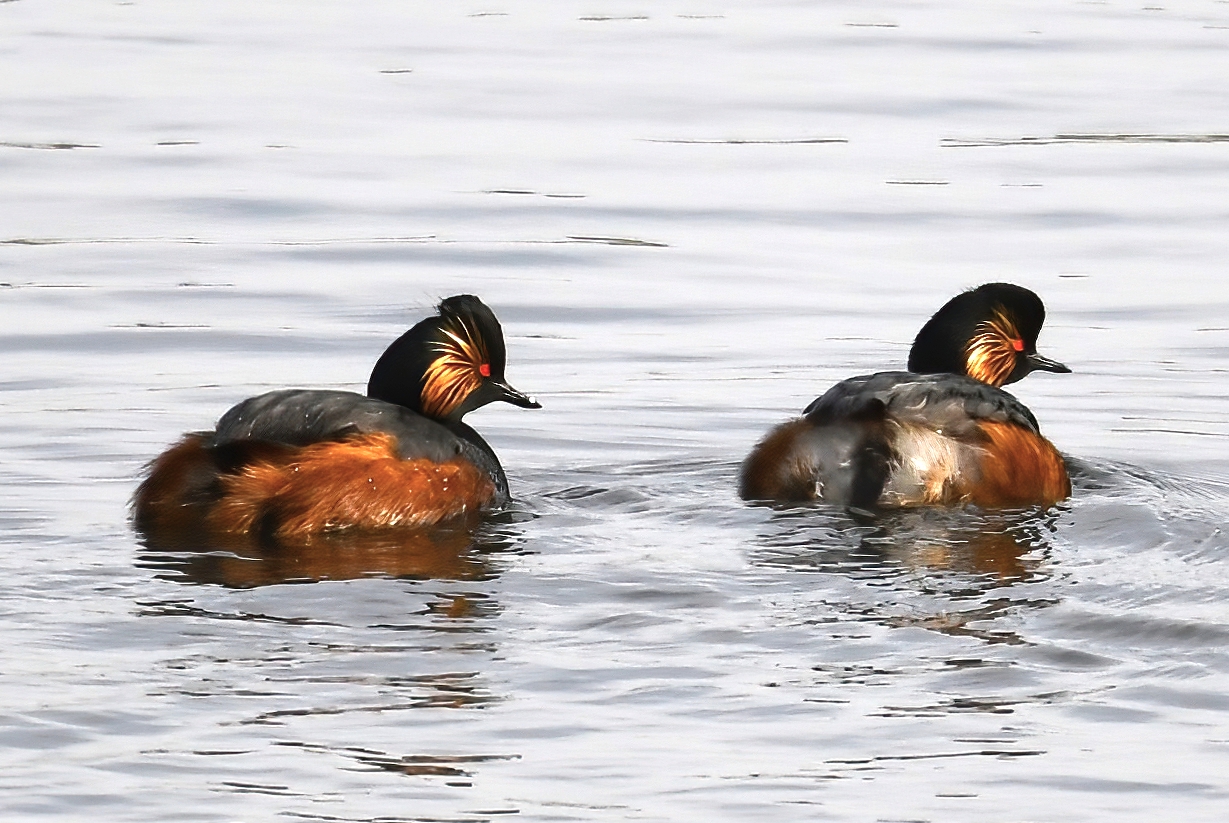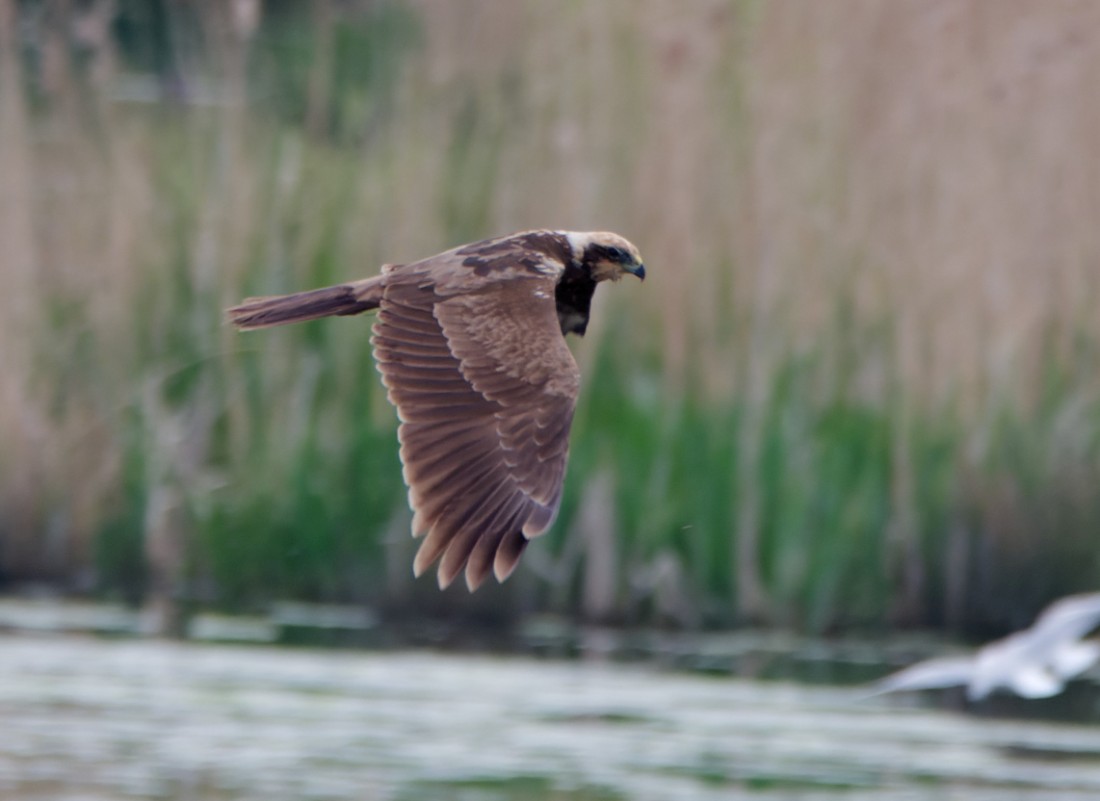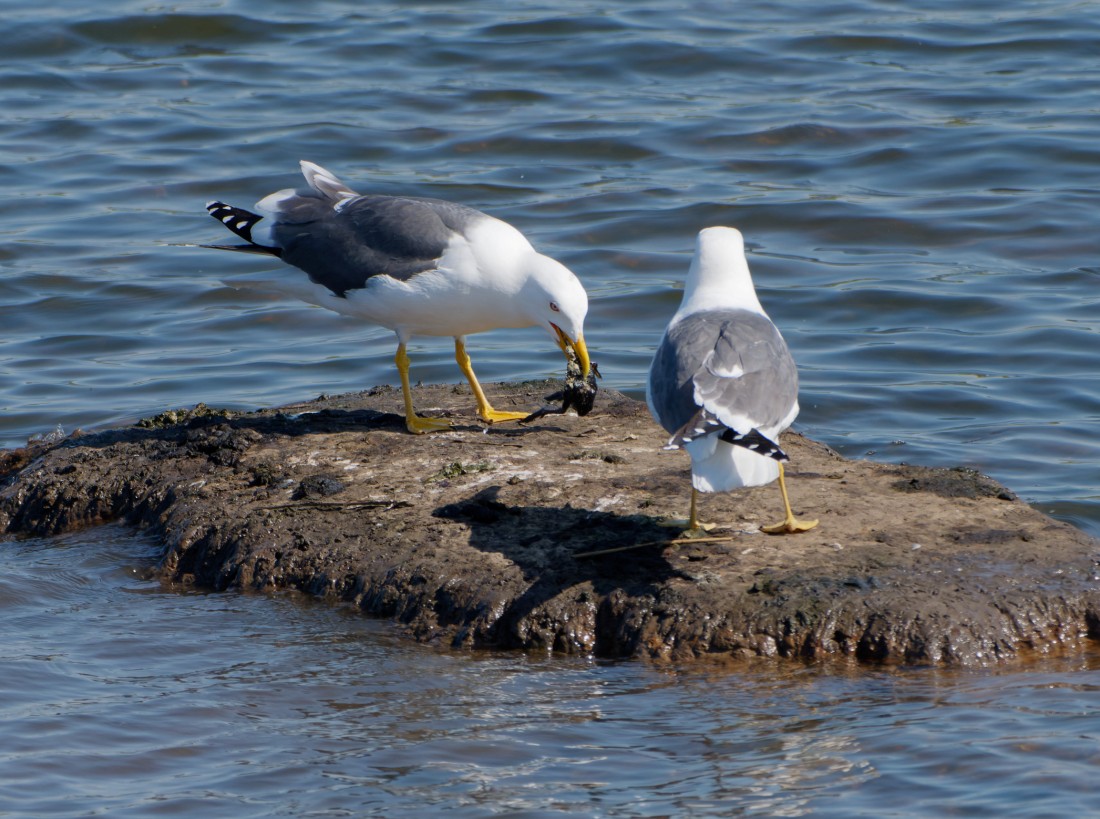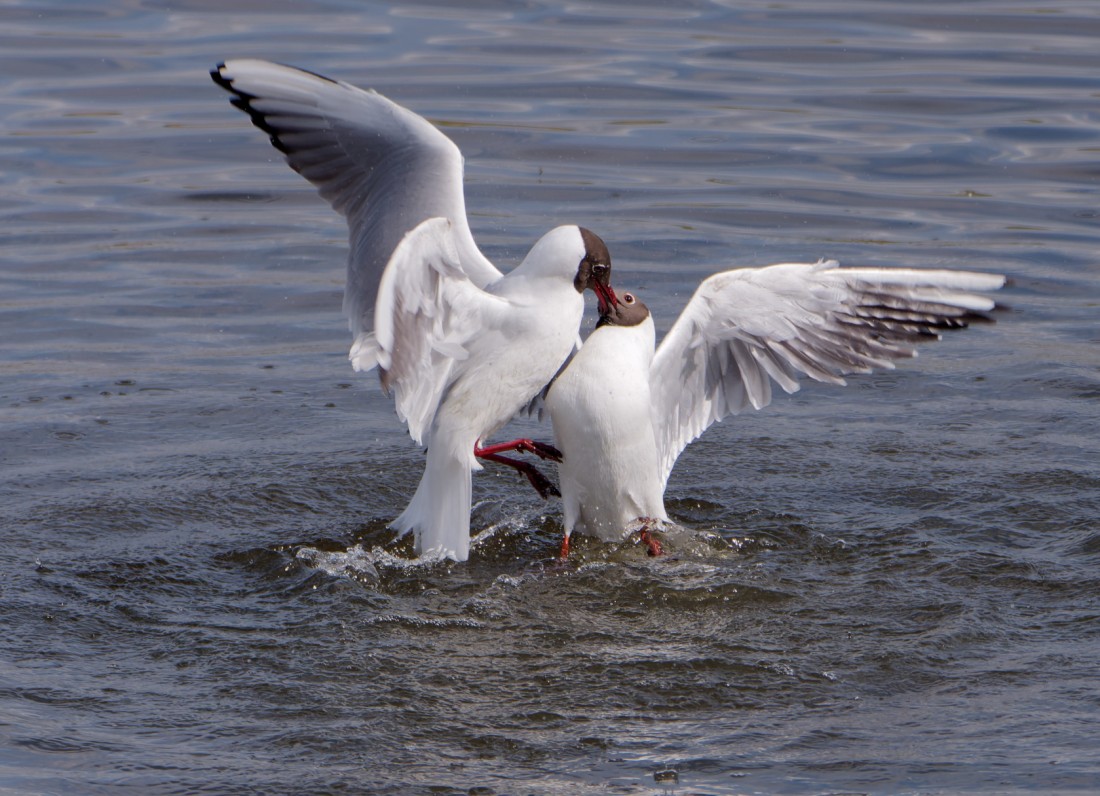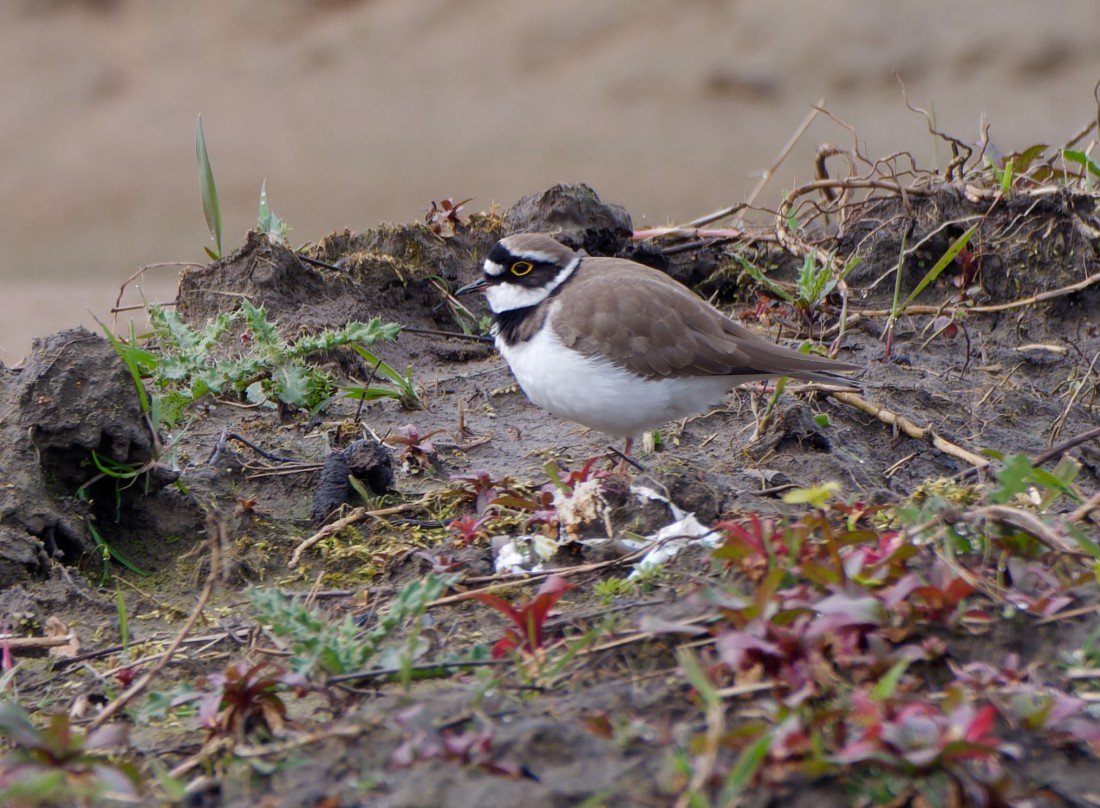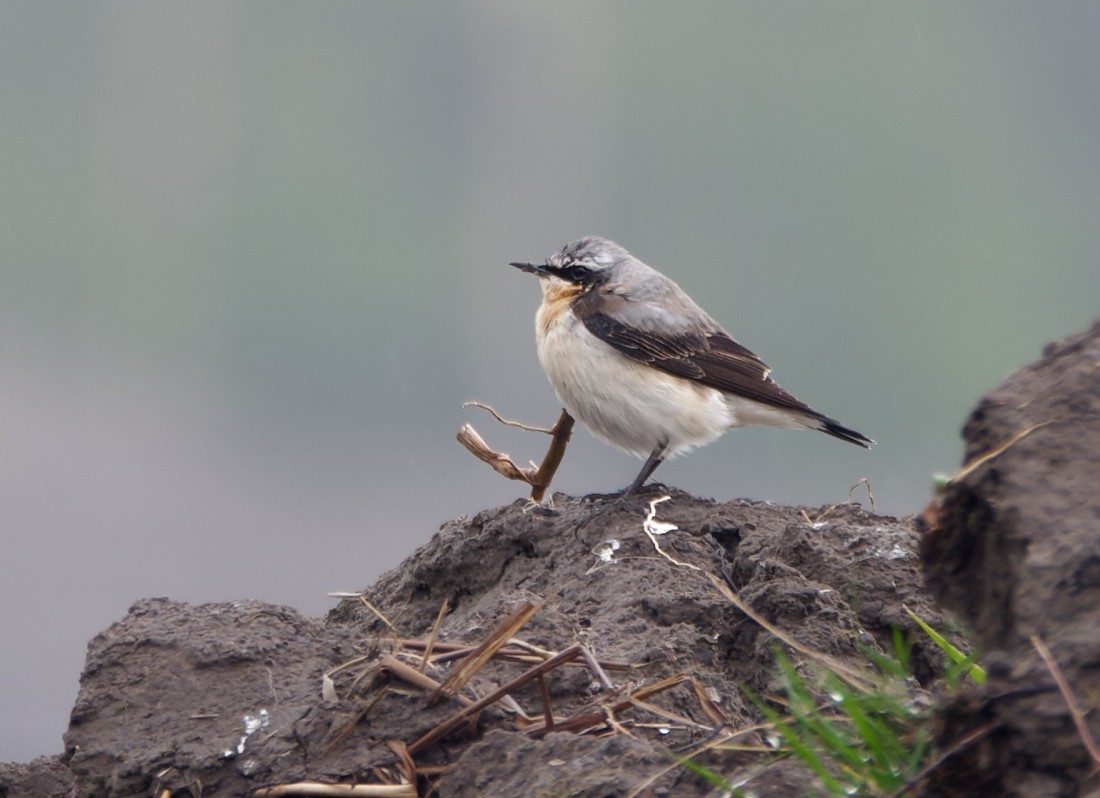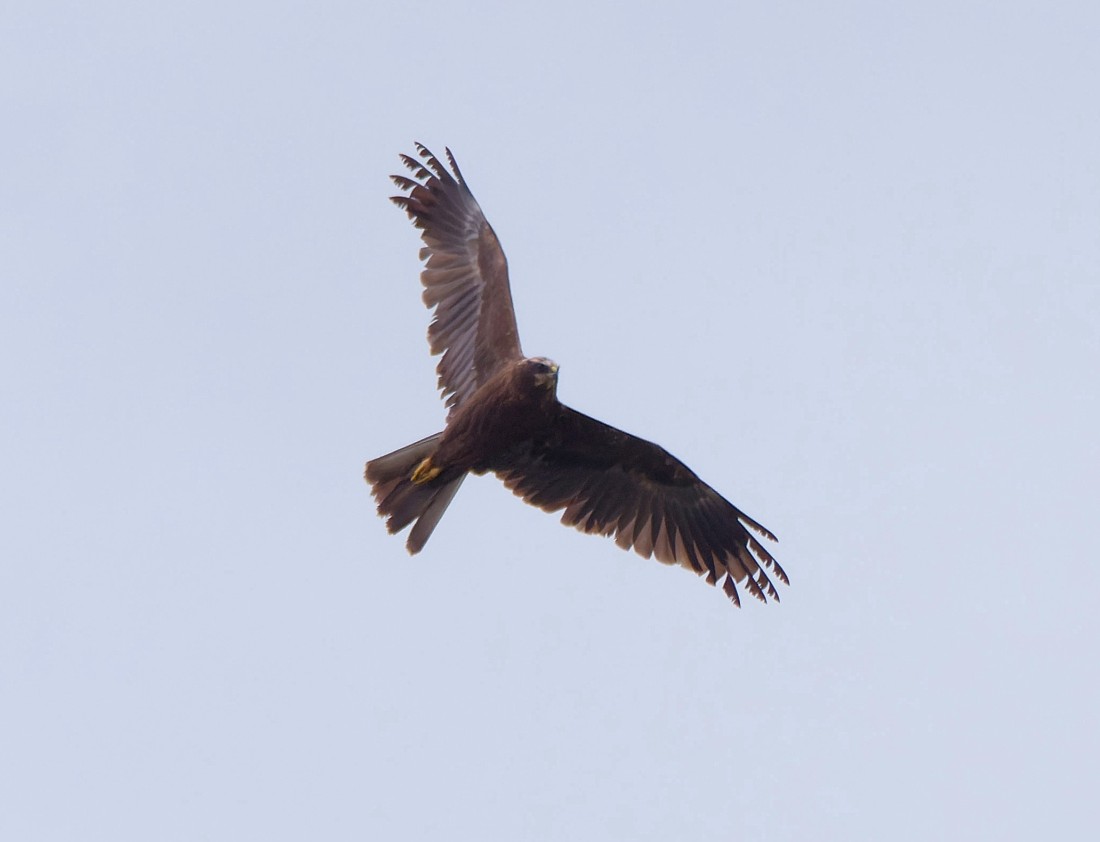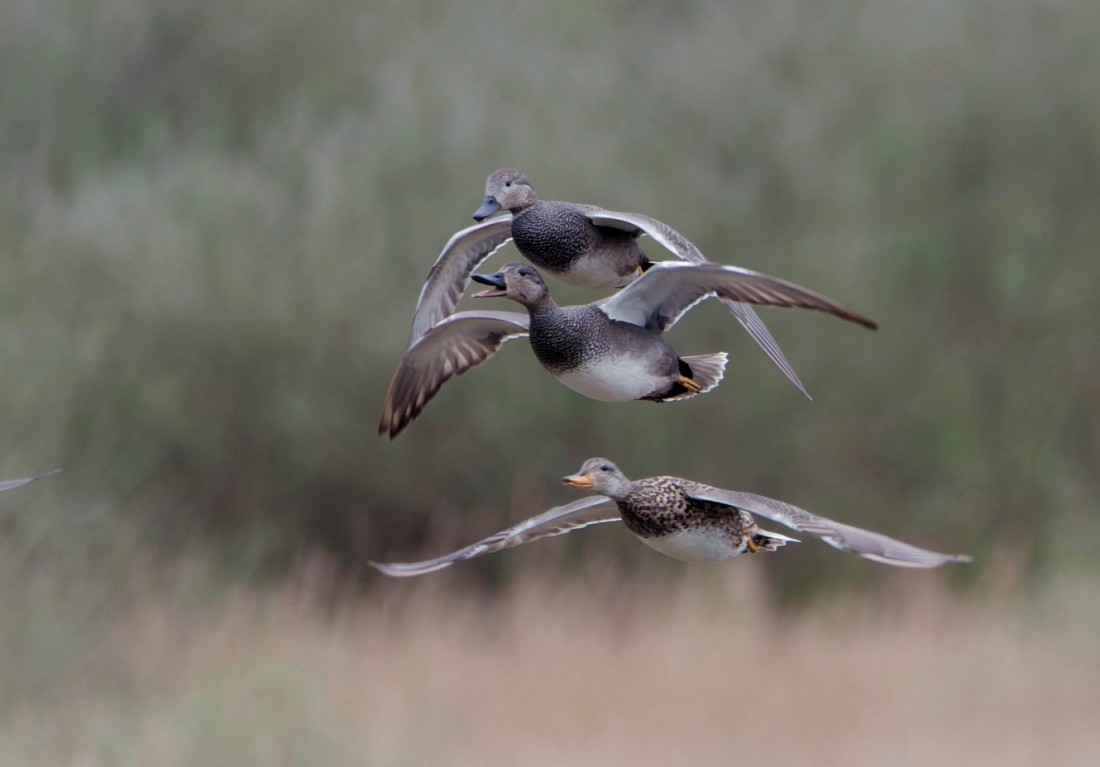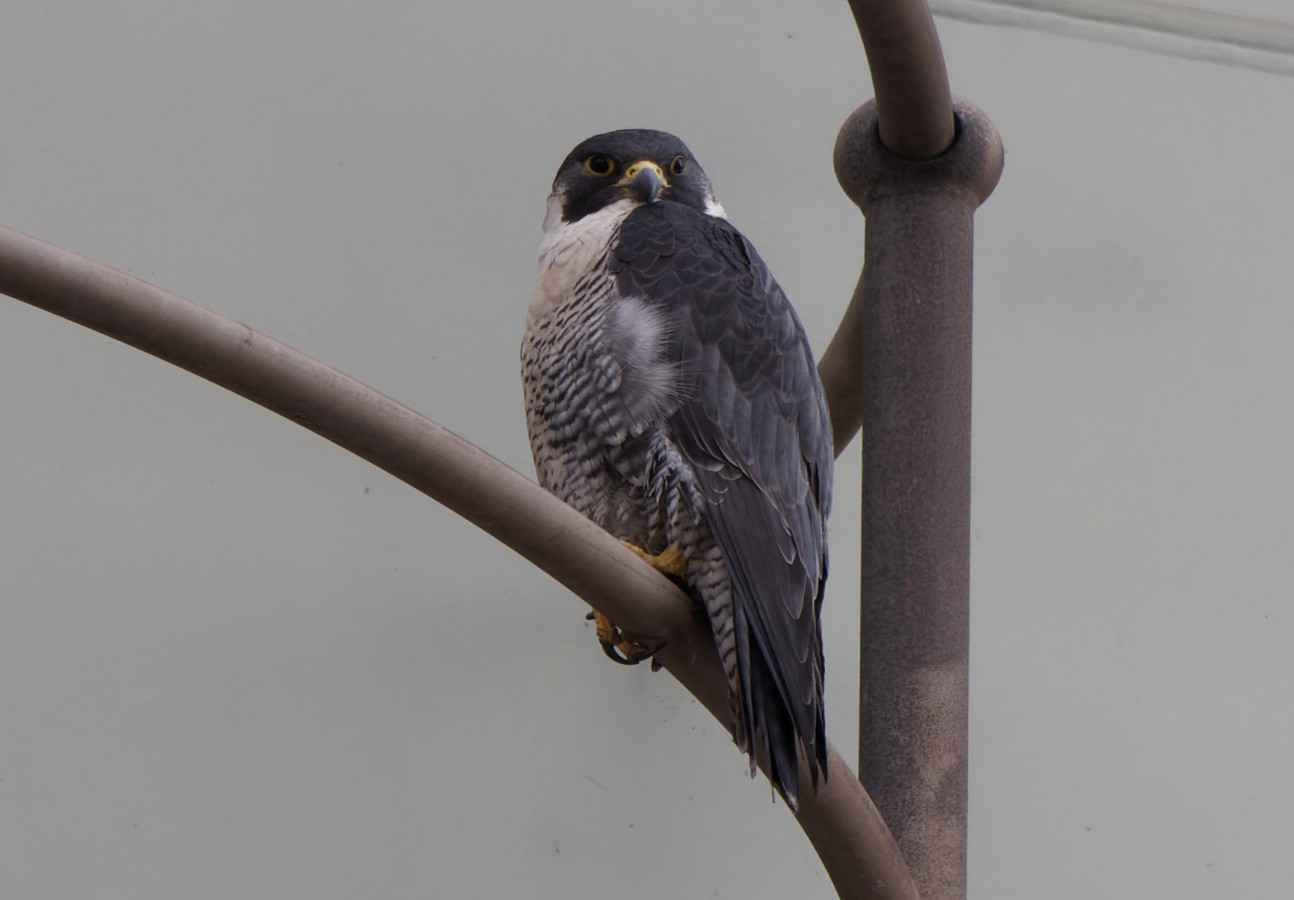Woolston Eyes Monthly Sightings
2022-04-17
2 Black-necked Grebes taken in good light from the south screen, no. 3 bed.
Submitted by: David Collis
2022-04-30
Well, after Thursday’s Temminck’s Stint, it was another spectacular morning. We started on No.4 bed, where the highlights were our first 4 Swifts of the year, 5 Yellow Wagtails, a few score of all three hirundines and 6 species of wader. Then it was off to No.3 bed, supposedly for a relaxing hour or so in the Morgan Hide. It would have been, too, if sharp-eyed Daniel Owen hadn’t picked out a female Ferruginous Duck consorting with Tufted Ducks. Ferruginous Ducks are a very scarce bird in Cheshire, as well as on the Reserve. They breed predominantly in south-eastern Europe and all the way across to western Mongolia. They have been in serious decline over the past couple of decades and it was beginning to feel like we might not see another one at Woolston. The link is to a short video showing a Fox on No.4 bed and the Ferruginous Duck on No.3!
CLICK HERE… to watch David’s video or simply copy the link below into your browser
https://youtu.be/PIjnRBvomf0 Cheers David Bowman (with Daniel Owen, Helen Wynn and Sue Haddock)
Submitted by: David Bowman
2022-04-29
Yesterday at Woolston Eyes, Dan Daniel Owen and I had pretty well given up on seeing any significant wader passage through the new No.4 bed Wetland and were amusing ourselves by trying to photograph some of the scores of Swallows, Sand Martins and House Martins. The arrival of a Temminck’s Stint, just the third for the Reserve in over forty years, in company with a Dunlin, was a really nice surprise and by the end of the day the wader list stood at nine species, with hopefully more to come. They were: Temminck’s Stint, Dunlin, Green Sandpiper, Little Ringed Plover, Ringed Plover, Common Sandpiper, Snipe, Oystercatcher and Lapwing. Record shot of the Temminck’s Stint Cheers David Bowman
Submitted by: David Bowman
2022-04-28
On a relatively quiet day, Daniel Owen and I were on No.4 bed, bemoaning the lack of passage waders on the new wetland. Sharp-eared Dan then heard a Dunlin calling and we watched what we thought were two Dunlin fly in to land not far away from us. I started to photograph one of the “Dunlins” when Dan called my attention to the second bird, which was hunkered down, as it was clearly smaller than the Dunlin. I was delighted to see that it showed the clear breast-band, yellow legs and distinctive shape of a Temminck’s Stint, the same conclusion Dan had already reached. These tiny waders breed in boggy areas right across the Arctic Taiga and spend the winter in tropical Africa. They are a very scarce migrant in Cheshire and this is only the second one to turn up on the Reserve, the last one being in 1989. After all our complaints, we ended the morning with eight species of wader with Green Sandpiper, Little Ringed Plovers, Ringed Plovers, Oystercatcher, Common Snipe and Lapwing keeping the Dunlin and this little gem company.
The link is to a short video of the stint. CLICK HERE…. to watch David’s video or copy the link below into ypur browser https://youtu.be/xDQZazI0V2k Cheers David
Submitted by: David Bowman
2022-04-26
A few odds and ends from Nos 1 and 2 bed to add to David and Dan’s sightings for today. A second Garden Warbler was in song on the south bank of No.2 bed. A Snipe was flushed on No.1 bed and a male Brimstone was on Butchersfield Tip. A Mallard with 7 very small young was on the river near the Fish Refuge where both Reed and Sedge Warblers were singing. On the flooded fields to the north of No.2 bed were a Grey Wagtail and a Little Ringed Plover and finally a Holly Blue flew up into a Holly tree along the river.
Submitted by: Dave Hackett
2022-04-26
It was sunny with a light but cool south-easterly breeze this morning, as migrants continued to straggle in despite slightly adverse conditions further south. The single Lesser Whitethroat, Garden Warbler and Sedge Warbler, which were in song on No.4 bed, were new arrivals as were the increased numbers of Common Whitethroats on the bed. In No.3 bed hirundines remain at a trickle rather than a flood, with just 1 House Martin, 32 Sand Martins and 23 Swallows noted, bringing in with them a Hobby which flashed past the window of the Morgan Hide. Other sightings of interest included: a new Marsh Harrier, which arrived, hunted for an hour so and then soared away to the west, a male Yellow Wagtail, 2 adult Mediterranean Gulls, 21 Black-necked Grebes, a couple of Common Snipe, 2 Kingfishers and a Peregrine which stooped through a passing flock of pigeons. As for our breeding water-birds, an early brood of Gadwall has been joined by 2 broods of Coot, 2 broods of Moorhen, 6 broods of Greylag Goose and 2 broods of Canada Goose. Photo of the Marsh Harrier Cheers David Bowman (with Daniel Owen)
Submitted by: David Bowman
2022-04-23
Another sunny day with a cool, blustery easterly yet still the expected rush of migrants failed to materialise. Birds of the day were undoubtedly the two Glossy Ibis which Mike Miles watched flying north-west at height over No.3 bed while the rest of us were completing a Breeding Bird Survey on No.1 bed. It’s tempting to think that these are the same two individuals which Daniel Owen and I saw earlier in the year on No.3 bed. The highlights of our own counts were: 4 Little Ringed Plovers, 3 Oystercatchers, 1 Snipe, 57 House Martins, 18 Swallows, 26 Sand Martins, 1 Sedge Warbler, 1 Raven, 65 Bramblings, a male Marsh Harrier and a late Siskin. After watching two Lesser Black-backed Gulls predating our first Coot chick of the year on Thursday, it was good to see two more newly hatched Coot broods, of two and three young, emerge today. Photo of Lesser Black-backed Gull predating a Coot chick. Cheers David Bowman (with Daniel Owen, Helen Wynn, Brian Baird, Dave Steel and Sue Haddock)
Submitted by: David Bowman
2022-04-21
Despite the sunny conditions this morning, the bulk of the expected spring passage is still to arrive, due to blocking weather systems around the Mediterranean. It was just a trickle again today, with highlights of 1 Yellow Wagtail, 1 Common Sandpiper, 6 Little Ringed Plovers, 16 Swallows and 40 Sand Martins. On the other hand, our breeding water-birds are doing well, with 21 Black-necked Grebes noted (and with others surely now on nests) and our first broods of Coot, Moorhen, Greylag Goose and Gadwall. It looks particularly promising for the latter, as around 170 are still present and constantly engaged in courtship chases. Typically for this time of year we are also seeing predatory behaviour from Lesser Black-backed Gulls, with one injuring an adult Black-headed Gull and another catching and eating a young Coot. Bramblings have now largely departed, with just 40 counted, after what has been an exceptional winter/spring for the species. With over 500 ringed, several thousand must have passed through since January. The short video shows some of the species from earlier in the month, including a drake Garganey.
CLICK HERE… to watch David’s video or copy the following link into your browser
https://youtu.be/udlCI-0RiIg Cheers David Bowman (with Daniel Owen)
Submitted by: David Bowman
2022-04-20
Completed a butterfly survey of the whole reserve. Totals as follow; 43 peacock, 33 orange tip, 20 green-veined white, 23 small tortoiseshell, 18 speckled wood, 3 comma, 1 small white, 1 large white and 1 holly blue. In all 143 butterflies of nine species. Unfortunately no brimstone seen!
Submitted by: Dave Hackett
2022-04-19
On yet another beautiful spring morning Daniel Owen and I completed a dawn Breeding Bird Survey of No.4 bed before scanning for migrants from the Morgan Hide. Seven species of wader were present on No.4 bed, with the highlight being our earliest ever Wood Sandpiper. In total we counted almost 300 birds in song on the bed, with plenty of warblers, including: 12 Whitethroats, 7 Reed Warblers, 9 Willow Warblers, 40 Chiffchaffs and 41 Blackcaps, with plenty of time for more to arrive. On No.3 bed 5 Mediterranean Gulls, 2 Marsh Harriers and 16 Black-necked Grebes were notable, with other migrants including 13 Swallows and 36 Sand Martins. Hirundines in general have been in short supply so far this spring and we’re expecting a major influx any day now. Photo of squabbling Black-headed Gulls Cheers David Bowman
Submitted by: David Bowman
2022-04-18
WeBS Count 16/04/2022 Little Grebe 18, Great crested Grebe 25, Black-necked Grebe 29, Cormorant 17, Mute Swan 23, Grey Heron 2, Shelduck 16, Greylag 21, Canada Goose 60, Gadwall 177, Teal 41, Mallard 67, Shoveler 37, Garganey 1, Pintail 1, Pochard 43, Tufted Duck 195, Water Rail 3, Moorhen 24, Coot 102, Lapwing 3, Oystercatcher 1, Little Ringed Plover 4, Snipe 1, Common Sandpiper 1, Common Tern 1, B.h. Gull 500, GBB Gull 1, LBB Gull 25, Herring Gull 8, Kingfisher 4
Submitted by: Brian Martin
2022-04-17
As the winds have become more favourable over the past week or so, a good variety of our scarcer migrants have turned up, including Water Pipit, Sandwich Tern, Black Terns, Kittiwake, Garganey, Ospreys, Yellow Wagtails, White Wagtails and Wheatears. In addition, we’ve also seen a notable influx of warblers and Black-necked Grebes, with a peak count of 29 for the latter. Yesterday morning started well, too, with 200 Sand Martins leaving a roost on No.3 bed at dawn, along with 5 Whimbrels, which flew north-west, a Common Sandpiper on the Morgan Hide scrape and a Common Tern which was chased off by the Black-headed Gulls. Then it was a Breeding Bird Survey of No.2 bed, which produced the following counts of males in song: 24 Blackcaps, 33 Chiffchaffs, 6 Willow Warblers, 7 Cetti’s Warblers, 4 Whitethroats, 36 Wrens, 9 Dunnocks, 27 Robins, 5 Blue Tits, 4 Greenfinches, 5 Blackbirds, 2 Linnets, 3 Song Thrushes, 2 Goldcrests, 1 Chaffinch, 3 Great Tits and 1 Reed Bunting. Butterflies were more evident, too, with Counts of: 4 Brimstones, 14 Orange Tips, 3 Speckled Woods, 7 Small Tortoiseshells and 5 Peacocks. Photo of a Black-necked Grebe Cheers David Bowman (with Daniel Owen, Dave Steel, Brian Baird and Sue Haddock)
Submitted by: David Bowman
2022-04-16
LATE ENTRY FROM 14th April
Last night’s bright moon, clear sky and favourable wind always promised the likelihood of a further arrival of Black-necked Grebes. Sure enough, a minimum of 29 was present this morning, with a few others almost certainly tucked away on nests. While fair weather is great for over-night grebe arrivals, it’s less likely to bring down passing diurnal migrants and so it proved. Dan Owen and I worked hard to find just 1 Yellow Wagtail, 1 Swallow, 5 Whitethroats, 5 Reed Warblers, 1 Little Ringed Plover, 3 Curlews, 1 Redshank and 2 Oystercatchers, though there were still plenty of Willow Warblers, Blackcaps and Chiffchaffs in song around Nos.3 and 4 beds, along with 2 Marsh Harriers and 150 Bramblings. It won’t be long till the latter have all set off on their long journey to the Fenno-Scandian breeding grounds, so it was good to still hear them singing as accompaniment to our eight hour wander! Photo of a passing Little Ringed Plover Cheers David Bowman (with Daniel Owen)
Submitted by: David Bowman
2022-04-12
While this morning’s weather at wasn’t exactly spring-like, with a cool north-easterly and persistent drizzle, the conditions were perfect for bringing down passing migrants. Daniel Owen and I started and ended the day on No.4 bed, with a lengthy session in No.3 bed sandwiched in between. We ended up with a wide variety of species plus the kind of volume which makes the Reserve so special. Highlights were: a fly-through Kittiwake, 5 male Wheatears (including one showing the characteristics of the Greenland race), 2 White Wagtails, 1 Common Sandpiper, 1 Little Egret, 20 Black-necked Grebes, 3 Reed Warblers, 1 Sedge Warbler, 9 House Martins, 23 Swallows, 230 Sand Martins, 2 Mediterranean Gulls, 33 Willow Warblers, 63 Blackcaps, 87 Chiffchaffs, 150 Bramblings, 1 Marsh Harrier, 24 Little Grebes, 9 pairs of Lapwing, 3 Water Rails and a Kingfisher. Photo of a male Wheatear Cheers David Bowman
Submitted by: David Bowman
2022-04-10
An early start to carry out a common bird survey on the northern half of No.4 bed. Nothing out of the ordinary but some reasonable totals. Unfortunately I did not hear any Willow Warblers. Totals; 31 Chiffchaff and a further 13 on the southern half, 12 Pheasant, 10 Song Thrush, 16 Wren, 7 Blackcap, 13 Wood Pigeon, 13 Blackbird, 3 Dunnock, 6 Magpie, 1 Chaffinch, 6 Cetti’s Warbler, 1 Blue Tit, 2 Long-tailed Tit and 2 Crow.
Submitted by: Dave Hackett
2022-04-09
A typical April morning on No.3 bed, starting crisp and sunny, then squalls of hailstones and finishing with more sunshine and a cold north-westerly. Not surprising that not many migrants were moving, just 2 Swallows and 6 Sand Martins. Plenty of other stuff to keep our interest piqued, though, with 14 Black-necked Grebes, 3 Mediterranean Gulls, `150 Bramblings and 2 Marsh Harriers. Early on, Helen and I completed a breeding bird survey of the whole bed, with counts of singing males including: 4 Water Rails, 5 Willow Warblers, 10 Blackcaps, 27 Chiffchaffs, 8 Cetti’s Warblers, 5 Reed Buntings, 7 Song Thrushes, 5 Blackbirds, 5 Dunnocks, 21 Wrens, 24 Robins and 8 Great Tits. Photo of a Common Buzzard Cheers David Bowman (with Helen Wynn, Brian Baird and Brian Martin)
Submitted by: David Bowman
2022-04-07
A blustery morning with intermittent rain squalls didn’t prevent a few migrants from battling through today. Highlight was undoubtedly the Osprey which passed over on a northerly heading mid-morning. We get one or two every year, though it’s been a few years since one stayed around, catching fish in the Mersey and perching opposite the Morgan Hide to eat its catch. Two Swallows and 17 Sand Martins were also good to see though, with the wind due to swing to the south at the weekend, we should soon be seeing a mass arrival of both species. Other sightings of note were 11 Black-necked Grebes, two high-soaring Marsh Harriers, 200 Bramblings, 2 Water Rails, 1 Willow Warbler and 7 Blackcaps. Photo of a Marsh Harrier Cheers David Bowman (with Daniel Owen)
Submitted by: David Bowman
2022-04-05
On No.3 bed Black-necked Grebes were less visible than recently, hopefully taking shelter in the reed beds. Early on, 6 Curlews flew east, no doubt heading back to their upland breeding sites. This is the time of year when winter visitors are still present while the first summer migrants are trickling in. It was still surprising to see hundreds of Bramblings passing over northwards, while at least 200 more fed around the bed. it won’t be long before these colourful visitors from Fenno-Scandia have gone for another year. Equally, the 40 Redwings which dropped in will soon be heading off in the same direction. With adverse winds still prevailing we had to work hard for our in-coming summer migrants, with just 2 Swallows and 12 Sand Martins noted. There was plenty of raptor activity, though and along with the usual Buzzards, Kestrels and Sparrowhawks we enjoyed 2 hunting Marsh Harriers and a young male Peregrine which narrowly failed to catch a Black-headed Gull. A further bit of excitement came when an “escaped” Harris’s Hawk shot past the Morgan Hide window, chased by a comet-tail of gulls. Gulls were perhaps the main feature of the day, too, with 950 Black-headed Gulls at the colony, along with 4 adult Mediterranean Gulls, a pair of which were displaying on one of the nest rafts. Most interesting though was the passage of 41 Common Gulls, an exceptionally high count for the Reserve. Photo of a Gadwall courtship chase Cheers David Bowman
Submitted by: David Bowman
2022-04-02
There’s something special about spring birding at Woolston Eyes. It comes, I think, from the the exceptional volume and variety of species present combined with a landscape which can be surprisingly beautiful, given the urban surroundings. We started at dawn on No.4 bed, where 10 Black-necked Grebes, a Little Egret, a displaying Curlew, a male Pintail, 2 adult Mediterranean Gulls, 4 Willow Tits, 8 Blackcaps, 50 Chiffchaffs, 1 Willow Warbler, 10 Common Snipe and 32 Teal were among the many commoner species around the wetland areas. There were a couple of other surprises though, as 125 Bramblings poured over from the direction of No.3 bed, many of which were dropping in to feed in the crowns of Alders. Then, as we were leaving the bed Dan picked out a Siberian Chiffchaff, a scarce winter visitor from the far east of Russia. Then it was a relaxing couple of hours in No.3 bed, where a further 18 Black-necked Grebes and 2 Marsh Harriers were noted, though the undoubted highlight was the 200 Bramblings, scores of which were in song around the bed. Then it was a trudge round No.1 bed before returning to No.3 bed for the pleasing sightings of a Swallow and 7 Sand Martins. Photo of a Peregrine Falcon Cheers David Bowman (with Daniel Owen, Helen Wynn and Dave Steel)
Submitted by: David Bowman

